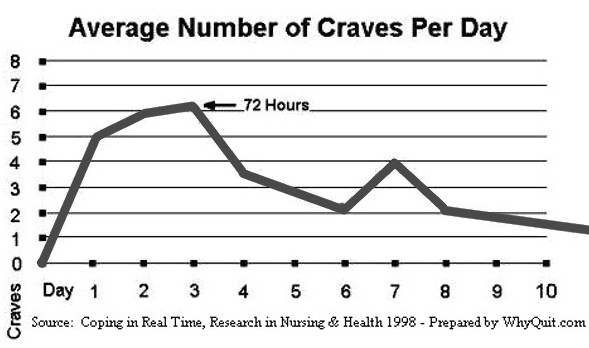Use triggers
You have conditioned your subconscious mind to expect nicotine when encountering certain locations, times, events, activities, people or emotions. Be prepared for each to trigger a brief crave episode.
Encountering a trigger cannot trigger relapse unless nicotine enters your body. But, take heart. Most triggers are silenced (extinguished) by a single encounter during which we intentionally deprive the subconscious of the expected result — nicotine.
Subconscious trigger extinction peaks during the first week.[1] All but infrequent, holiday and seasonal triggers should be extinguished within the first 2-3 weeks.
Infrequent cues may be associated with a vacation, a wedding, death, funeral, meeting an old friend, or an illness. Infrequent cues have their own histories.
The good news is that any remaining subconscious use associations were likely weak to begin with, as death and serious illness were hopefully rarely experienced.
Also, like the strength of any relationship, the mind's anxiety craving generator depends on new use memories for its punch. No new use memories are reinforcing thousands of old ones.
Thus, over time, cravings will not only grow further apart but shorter in duration and generally less intense. Eventually, they'll become laughable reminders of the amazing journey you've made.
Crave episodes are brief
In contrast to thought fixation—the "nice juicy steak" type of thinking that can last as long as our ability to maintain focus and concentration—it’s rare when any subconsciously triggered crave episode fails to peak within 3 minutes.
Time distortion
Research teaches us that early recovery causes significant time distortion. Although crave episodes almost always peak within 3 minutes, time distortion can make minutes feel like hours.
Keep a clock or watch handy to maintain an honest perspective on time.
Crave episode frequency
Unless hiding in a closet, you'll likely experience the bulk of your regular daily triggers within the first 3 days.
The following chart was created from a 1998 study in which smokers going through withdrawal used palm pilots to record their cravings as they occurred.[1] As you can see, the number of episodes peaked on day 3 with an average of 6.

That's a total of 18 minutes of challenge on their most challenging day.
But, what if you're not “average”? What if you established and must encounter twice as many nicotine-feeding cues or yours last twice as long?
That's 36 minutes of significant challenge. Can you handle 36 minutes of serious desire in order to reclaim your mind, priorities and life? Absolutely. We all can.
See that small spike on day 7? Could it reflect when they celebrated their first full week of freedom? Yes, for most of us, nicotine use was part of celebrations, including celebrations that turned sour.
Also, stay alert for subtle differences between crave triggers. For example, the Sunday newspaper is much thicker and may have required using twice.
Understanding the big crave
In the above-discussed cravings study, the average ex-smoker was experiencing just 1.4 crave episodes by day ten.
Shortly thereafter, it isn’t unusual to begin experiencing entire days without encountering a single un-extinguished use trigger.
If a later crave episode ever feels far more intense, it's likely that it has been some time since your last significant challenge and you've dropped your guard and defenses a bit.
You may panic. It can almost feel as though you've just received an unexpected blow to the gut.
If this should occur, stop, take a slow deep breath, and reflect on how long it has been since your last significant challenge. Then smile. The bigger the better. What a wonderful problem to have.
Confronting triggers
Recovery is about re-learning how to comfortably engage all aspects of life nicotine-free.
Why hide from healing? Why delay coming home? Meet, greet and extinguish your use triggers. You don’t need to give up anything except the highly addictive insecticide nicotine.
As you're about to discover, everything you did as a user can be done as well or better as an ex-user.
With each trigger extinguished, you’ll receive a prize, another piece of a puzzle that once complete will reflect you comfortably, calmly and confidently engaging all aspects of life nicotine-free.
References:
2. Klein LC, Smoking abstinence impairs time estimation accuracy in cigarette smokers, Psychopharmacology Bulletin, May 2003, Volume 37(1), Pages 90-95.
All rights reserved
Publication date: May 4, 2021
